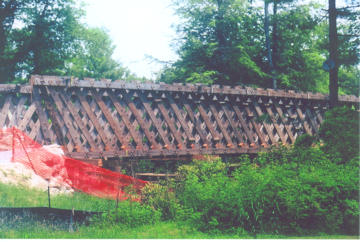bascom
A Center for the Visual Arts*
A striking, rough-hewn 87-foot-5-inch long covered bridge serves as the welcoming entrance to The Bascom's six-acre campus in Highlands, North Carolina.
 |
Photo by Howard Rogers, July2, 2008 |
In the 1960s, the Bagley bridge was unfit for vehicular and pedestrian use. Warner, New Hampshire, authorities numbered the parts and disassembled it. Bridgewright and restoration conservationist Arnold M. Graton purchased the structure and put the parts into storage. In 2007, Franklin, North Carolina, native Wayne Yonce located the bridge and recommended it to The Bascom Board of Directors as a potential signature feature for their planned campus. The Bascom hired Arnold M. Graton Associates, Inc. of New Hampshire to move the Bagley bridge to Highlands and undertake the reconstruction of the structure for the art center's use.
The Bascom renamed the structure the Will Henry Stevens Covered Bridge in honor of the notable New Orleans artist and teacher. A pioneer of modernism in the American South, Will Henry Stevens (American, 1881-1949) was passionate not only about the bayous of coastal Louisiana, but also about the mountains of Western North Carolina, where he summered and painted. The Bascom owns his work, and selections will be on exhibition from time to time in its new facility. The Will Henry Stevens Covered Bridge is a reconstruction by Arnold M. Graton featuring a lattice style that was patented by Ithiel Town in 1820 and 1835.
Graton's reconstruction process has been meticulous. He utilized centuries-old craft techniques and replaced rotten, insect-ridden or unstable parts. Rough-hewn parts were constructed out of white pine, oak, Douglas fir and other old~growth native species. Replacement wooden parts constitute about 60% of the bridge. No metal fasteners or screws, nuts or bolts are used in the bridge construction, only wood. Tree nails, trunnels or dowelsó1,100 of themójoin the wooden parts. Says Graton: "Wooden bridges far outlive the concrete ones, lasting 100 years or more as long as they stay high and dry."
The Bascom's bridge incorporates the distinctive Town's Lattice Truss style developed by architect Ithiel Town (American, 1784-1844). On January 28, 1820, Town was granted his first patent for this form of wooden truss bridge. The design had great importance because it could be built quickly by relatively unskilled workers from readily available material. The truss design also avoided the need for the wide piers needed for stone arches. The design was widely used throughout the United States and made Town wealthy. Town's truss design can still be seen in two of Connecticut's extant covered bridges, Bull's Bridge in Kent and West Cornwall Bridge in Cornwall and Sharon, and in New York's Eagleville Bridge and Shushan Bridge. Many other surviving covered bridges employ Town's design, including an "improved version" used in the construction of the Bunker Hill covered bridge in North Carolina.
Arnold M. Graton, bridgewright and restoration conservationist, works with vintage bridges and other wooden structures, e.g. barns, churches, mills and bridges. His goal is to preserve the past for our future. With The Bascom's Will Henry Stevens Bridge, Graton hopes for a lifespan of 300 years! For more information, see: http://arnoldmgraton.com.
Dave Fischetti, PE, of DCF Engineering, Inc., Cary, North Carolina, worked in tandem with Graton on the reconstruction of The Bascom's covered bridge. Fischetti is known for his work on nationally significant historic restoration and adaptive reuse projects, including the Bunker Hill covered bridge in Claremont, North Carolina, one of only two surviving original covered bridges in the state.
[*Edited from the Bascom Center for the Arts Fact Sheet forwarded by VCBS member Howard Rogers-Ed.]
 Joe Nelson, P.O Box 267, Jericho, VT 05465-0267
This file posted 08/25/2008
Joe Nelson, P.O Box 267, Jericho, VT 05465-0267
This file posted 08/25/2008
 Return to Archives
Return to Archives